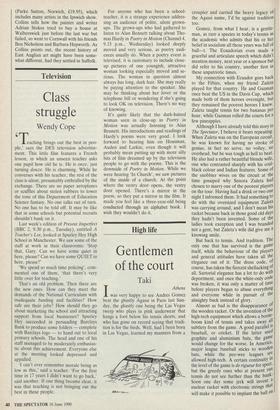Exhibitions 2
Earth, Sea and Sky: Artists of the Suffolk Landscape 1880-1950 (Christchurch Mansion, Ipswich, till 15 July)
Drawn to East Anglia
John Henshall
East Anglia is going quietly art-mad this summer. A series of 20 exhibitions under the umbrella title Visions of East Anglia has been co-ordinated to span the gamut of the region's many artists, sculp- tors and craftspeople. It covers masters like Constable and Gainsborough, the influential Norwich School, lesser-known if no less worthy figures from the compara- tively recent past and young practitioners developing their talents today. The flagship show must be the Ipswich exhibi- tion, in the sublime setting of the 16th— century Christchurch Mansion, in the town centre.
Numerous artists have painted Suffolk's undulating countryside, whether as resi- dents or as bewitched passers-through, compelled to linger by the region's unique beauty. The Ipswich exhibition features well-known figures like Philip Wilson Steer, John Nash and Edward Middle- ditch, but its curators are to be com- mended for homing in fearlessly on the more obscure artists who formed what constituted the nearest thing to an Ipswich School: Walter Batley, Frederic George Cotman and others, who in 1875 started the Ipswich Fine Art Club.
Batley and Cotman deserve special attention. Batley (1850-1936), who de- veloped a particularly keen perception of how the Suffolk landscape, its forms and colours blend into a resolutely impress- ionistic whole, eschewing excessive detail, was born in Ipswich, and became an artist almost by accident. He was a sickly child, whose father bought a cottage at Felix- stowe, hoping sea air might aid his health. Often unwell, Batley spent hours at an easel. When his mother suggested helpfully that he become a hatter, he countered in the nicest possible way that she must be as mad as one. He went to local art college, then the Royal Academy Schools.
He did his finest work in the winding lanes through the wild, unspoilt woodland which until just before the last war fringed north Ipswich: near Tuddenham, Rush- mere and Kesgrave, now marred by urban sprawl. He is represented here by his glorious 'Snow' (1915), a muscular, icy interpretation of what is probably Ipswich's Sidegate Lane area, then a coun- try track. Cotman (1850-1920) was the nephew of the Norwich School master John Sell Cot- man, but was born in Ipswich. He was outgoing, socially ambitious and did much society portraiture: he reputedly once toured the Mediterranean with the Duke of Wellington and family. Again, though, East Anglia was his first love: Lowestoft, Ipswich and the area around St Ives, Cambridgeshire. 'Farmyard and Dove- cotes, Nettlestead'. (1912) is a sound ex- ample of his local work.
Philip Wilson Steer's sparkling 'Knuck- lebones, Walberswick' (1888-89), with youngsters disporting themselves on a beach of quasi-surrealistic red, cream and purple pebbles, is a high point of the show. Leonard Squirrel, one of the best painters of East Anglian townscapes, especially his native Ipswich, has a superb pastel of the high street at Kersey (1928). The Essex- born Harry Becker (1865-1928), who turned his back on London to record the decidedly unarcadian lives of the farmwor- kers of north Suffolk, is well represented by some of the evocatively colourful, almost Continental field scenes which earned him the nickname 'the Suffolk Impressionist'.
Those who visit Christchurch Mansion for this show should note that the Wolsey Art Gallery there has a fine collection of Constables and Gainsboroughs. The whole series of exhibitions, details of which can be got from the Eastern Arts Association on 0223 215355, is neatly complemented by the publication of A Broad Canvas: Art in East Anglia since 1880 by Ian Collins 'Farmyard and Dovecotes, Nettlestead', 1912, by Frederic George Cotman, a ounder member of the Ipswich Fine Arts Club (Parke Sutton, Norwich, £19.95), which includes many artists in the Ipswich show. Collins tells how the painter and writer Adrian Stokes tried to buy a house at Walberswick just before the last war but failed, so went to Cornwall with his friends Ben Nicholson and Barbara Hepworth. As Collins points out, the recent history of East Anglian art might have been some- what different, had they settled in Suffolk.



















































 Previous page
Previous page